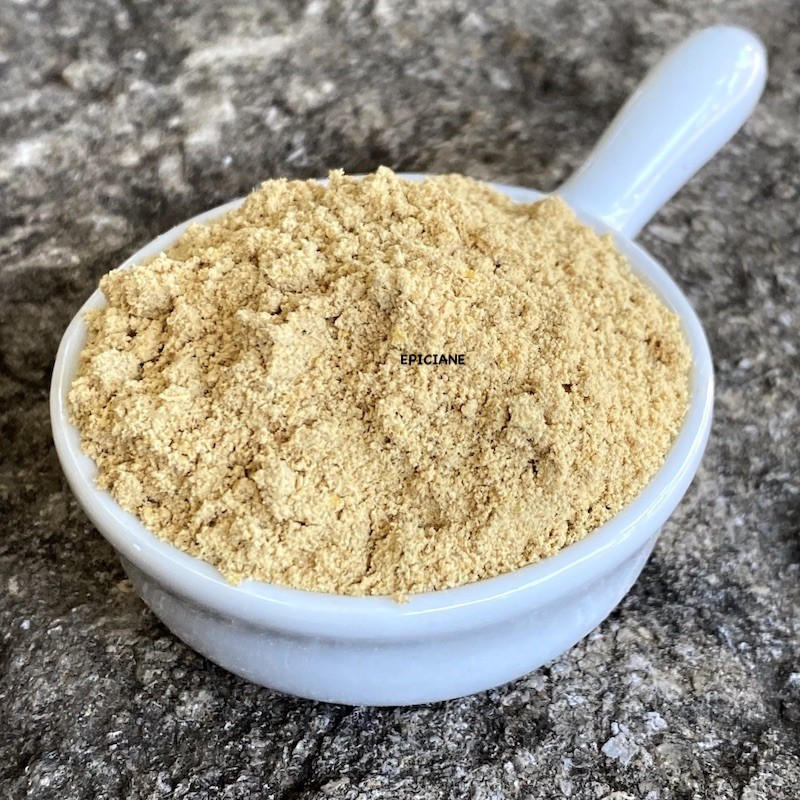
Reference: carrymadras


The taste of this powdered root is spicy, peppery, and slightly lemony.
It is delicious in fish dishes, pastries (such as gingerbread), and is essential in Asian, Indian, and North African cuisines.
 Delivery
Delivery
Mondial Relay
 Returns
Returns
See conditions
 Payments
Payments
100% secure
- Livré en sachet refermable -
Uses in Cooking and Beyond:
Here, the whole rhizome (i.e., the root) is dehydrated and ground. This extremely fine white powder is perfect for flavoring numerous dishes, but in liquids (alcohol, teas, fruit juices, etc.), it’s preferable to use the whole ginger, which can be left whole or simply cut into small pieces with scissors to avoid any residue in the liquid.
The taste of ground ginger is peppery, spicy, lemony, and warm, intensifying as the rhizome matures: the taste of young roots is almost mild, while it becomes strong in older rhizomes.
Ginger is a highly used spice in a myriad of spice blends and in many cuisines worldwide: Asian, Indian, North African, and even now in the West. In India, it’s part of curries, garam masala, and masala. In North Africa, it contributes to "ras el hanout," and in China, hardly a dish goes without it! Combined with star anise, it is delicious in fish sauces. It also wonderfully enhances tomato sauces and white meats like chicken.
Ginger is also used in baking (gingerbread, cookies), as well as in tea and alcoholic drinks like punches and hippocras. It can also be made into refreshing, tonic drinks and herbal teas. In Canada, "ginger ale," a soft, carbonated, non-alcoholic drink, inspired the famous soda "Canada Dry." In France, near Jarnac, a ginger-based liqueur is produced.
In China, ginger is often enjoyed as candied rhizomes, a popular treat.
Who am I?
Origin: Nigeria
Scientific name: Zingiber officinale
Ginger is a species native to Asia, part of the Zingiberaceae family, whose rhizome (the root) is used in cooking and traditional medicine. It is a tropical herbaceous plant about 0.90m tall that emerges from the rhizome. The evergreen leaves are long and fragrant, and the flowers are white and yellow spotted with red, with green and yellow bracts. After flowering, a short spike with black seeds enclosed in capsules appears at the end of a scaly-covered stem. Ginger prefers sunny exposures and a warm, humid atmosphere. It grows quickly and multiplies only by division of rhizomes.
India and China together produce over 50% of the world's consumption. Today, ginger is cultivated in all hot regions worldwide.
Two other plants are closely related to ginger: "wild ginger," from the Aristolochiaceae family, native to North America, with similar taste and properties, and turmeric, whose rhizome pulp is bright yellow and has numerous medicinal benefits.
Ginger contains around forty antioxidant compounds, and like its relative turmeric, is attributed with numerous benefits, including alleviating nausea in pregnant women and motion sickness (Chinese sailors chewed it to prevent seasickness).
Moreover, some of these compounds are heat-resistant and may even be released during cooking.
A Little History:
Unlike most plants, ginger has lost the ability to reproduce by seeds and can only multiply by its rhizome, suggesting it has been domesticated for a long time. All commercial ginger consists of clones from very old cultivars, possibly dating back to the beginnings of agriculture, around 12,000 years ago. These cultivars are resistant to almost all diseases and pests, which has allowed them to endure over time.
Ginger has been used as a condiment and medicinal plant for over 5,000 years, though its wild ancestors have never been found.
Indian writings from 1000 B.C. prescribed this plant for various ailments. Chinese physicians continue to use it extensively to this day.
Ginger was called "zenj" by Arab traders, after the people of East Africa from whom they sourced it, a term that also gave rise to "Zanzibar." These traders introduced it to Europe around 1000 B.C. It was known in France and Germany by the 9th century. The Spanish, during their conquests, introduced it to the Caribbean and Mexico, from where they could then export it.
The word "ginger" first appeared in French writings in 1256. This name is derived from a Sanskrit term meaning "in the shape of a deer’s antler," relating to the shape of the plant's roots.
Data sheet
 Anthony V.
Anthony V.
Top
 Julie F.
Julie F.
Parfait !! Je recommande +.

 Anthony V.
Anthony V.
Top
 Julie F.
Julie F.
Parfait !! Je recommande +.

Reference: carrymadras
Reference: gingembreE
Reference: EPI2301003
Reference: 20703402
Reference: 8N7625101
Reference: badianeE
Reference: 3N7153402
Reference: 124510
Reference: 208037909
Reference: 20701706
Reference: 2071570
Reference: 00723801
Reference: 208037910
Reference: fenouilE
Reference: 208022801
Reference: 00029083-0001
Reference: 20820902
Reference: anisvertM
Reference: badianeM

The taste of this powdered root is spicy, peppery, and slightly lemony.
It is delicious in fish dishes, pastries (such as gingerbread), and is essential in Asian, Indian, and North African cuisines.